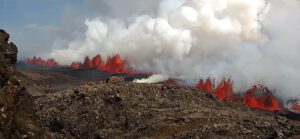Lava flow along the protective walls at Grindavik
 The eruption that began this afternoon in Iceland is ongoing, although it has significantly weakened after a very intense initial phase. Nevertheless, a substantial amount of lava is still flowing, reaching the protective barriers northeast of Grindavik. These barriers have successfully redirected the fast-moving lava, causing it to flow around the town along the earthen fortifications that semi-circle Grindavik. The lava reached the western outskirts of the town, where the antenna installation is located, which is also protected by an earth wall. The lava flow is relatively close to the coast, and an ocean entry is not ruled out. The lava crossed the main road between Thorbjörn and Grindavik, cutting it off for the third time. This is the fifth eruption in the series.
The eruption that began this afternoon in Iceland is ongoing, although it has significantly weakened after a very intense initial phase. Nevertheless, a substantial amount of lava is still flowing, reaching the protective barriers northeast of Grindavik. These barriers have successfully redirected the fast-moving lava, causing it to flow around the town along the earthen fortifications that semi-circle Grindavik. The lava reached the western outskirts of the town, where the antenna installation is located, which is also protected by an earth wall. The lava flow is relatively close to the coast, and an ocean entry is not ruled out. The lava crossed the main road between Thorbjörn and Grindavik, cutting it off for the third time. This is the fifth eruption in the series.
The Icelandic Meteorological Office (IMO) has released initial data on the event. The total length of the main fissure was 3.4 kilometers, with its southern end reaching approximately 1 kilometer from the protective barriers northeast of Grindavik. The initial lava output rate was about 2000 cubic meters per second. Another fissure segment opened west of the most recently active crater from the March 16 eruption, with a reported output rate of about 1000 cubic meters per second. Preliminary data suggest this was the strongest initial phase of the eruptions in this series.
The southern end of the main fissure has now almost ceased its activity. In the final phase, a series of explosions occurred, expelling light brown ash from fragmented older lava, along with fresh tephra and steam. Gas pistons may have formed as the magma conduit emptied. It is also possible that groundwater came into contact with lava, causing the explosions.